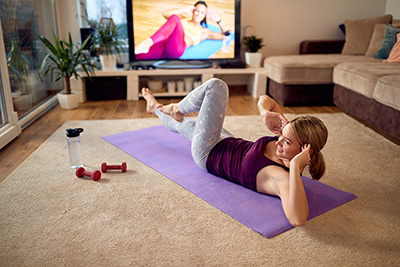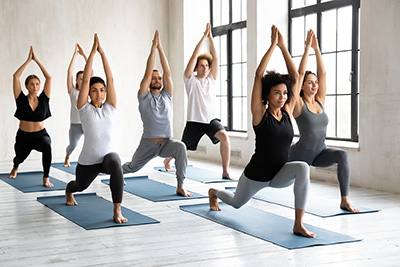Before Joining a Gym, Exercise Your Options
Last updated May 2023
 If you’re thinking of joining a gym (or buying a treadmill or signing up for online workouts), know that the fitness industry thrives on good intentions. Most people who join gyms stop using them after only a few months—though many workout dropouts continue to pay monthly membership fees.
If you’re thinking of joining a gym (or buying a treadmill or signing up for online workouts), know that the fitness industry thrives on good intentions. Most people who join gyms stop using them after only a few months—though many workout dropouts continue to pay monthly membership fees.
There are many fitness facilities offering many types of workout experiences, each with at least a few membership or usage options. And because some clubs’ staff use high-pressure sales tactics, it’s not always easy to make a choice.
But before joining a gym, think about your own motivations and interests—and consider alternatives. Do you need to pay a company big bucks for activities available for free or for less money elsewhere?
First, Make a Plan
While there are lots of ways to stay or get fit—long walks, pushups and sit-ups, regular tennis or pickleball games, taking the stairs instead of the elevator—all require commitment. For most people, beginning a new exercise routine is like quitting a bad habit: the more doable it is (and the more you enjoy spinning/basketball/hot yoga), the more likely you’ll succeed. It also helps if your new exercise regimen includes opportunities to see friends or meet new ones. So does an attractive facility.
Start by setting realistic fitness goals, deciding which exercises will help you achieve them, and committing to a schedule. Make a list of reasons and refer to them if your enthusiasm flags. And if you are older than 40, review your plan with a physician before beginning.
Exercise Your Options
The COVID pandemic had a dramatic impact on the fitness industry. There are now myriad options for working out at home or with small groups that allow consumers to exercise without having to schlep to crowded gyms.
Below we provide alternatives to conventional fitness clubs. Even if you’ll eventually join a gym, it’s worth spending a few weeks trying the alternatives. It’ll give you a better idea as to whether you’ll stick it out at a gym, and which activities and facilities matter to you.
 DIY Workouts
DIY Workouts
Many people get and stay fit for free (or nearly so) by doing pushups and sit-ups at home, and walking, running, and biking around their neighborhoods. A regular soccer or basketball game at a nearby park is not only cheap but possibly more fun than lugging weights around a smelly gym.
At-Home Classes
There are now more choices than ever for consumers who want to work out at home. Many options are free to cheap.
Streaming exercise classes were on the rise before the pandemic, with both informal free classes on YouTube (just search “yoga” or “free weights” for a zillion options) and via monthly subscription services (e.g., Daily Burn, obé Fitness, Glo, and CorePower Yoga). Peloton, the home cycle company, sells both its own screen-outfitted bikes and treadmills as well as a monthly subscription to classes that can be used with or without the bike.
Apps, which can be streamed via your phone, computer, or TV, cost from $13 to $30 a month. Most include both live and recorded classes of many types (weights, cardio); others, like CorePower Yoga, focus on one type of exercise. Many apps include interaction with instructors plus online “high fives” and camaraderie with other students.
The pandemic also forced many gyms to get into streaming wars, offering live or recorded classes via Zoom or other platforms. Now most gyms offer both in-person and streaming classes, a further sign of the changed-yet-flexible workout environment.
At-Home Equipment
For a one-time investment of a few hundred dollars, you can buy basic types of home exercise equipment—or pay $2,500 or more for high-end machines.
There are so many ex-exercisers that you can score good-as-new secondhand equipment for free or nearly so. Because many people want to get bulky equipment out of their homes, you might end up with a free piece of equipment if you’re willing to haul it. Join a Buy Nothing group to look for free castoffs, or buy for cheap at yard sales or from Craigslist and Facebook Marketplace listings.
 Government-Run Recreation Centers
Government-Run Recreation Centers
Local governments offer exercise facilities and programs. Recreation centers and local parks have cardio equipment, weight rooms, tennis courts, swimming pools, aerobics classes, basketball courts, sports leagues, and much more—all free or much cheaper than comparably equipped private health clubs.
For example, nine of Arlington County’s community centers have fitness centers. A six-month pass, which includes access to all facilities, is $102.50 for county residents ($360 at the Long Bridge location). A daily pass is $5 for adult county residents ($9 at Long Bridge), with discounts for older adults and youths.
For 2023, Montgomery County residents can obtain free passes to access fitness rooms and open gym activities at the county’s 22 recreation centers; many rec centers also have group exercise classes. Montgomery County also operates four indoor pools. Adult county residents pay $7 daily or $400 annually for access to all county pools; there are discounts for couples, older adults, and families. Six-month and three-month pool passes are also available.
Prince George’s County’s community centers offer good deals for older adults and teens living in suburban Maryland: Residents of Prince George’s and Montgomery County ages 60 and up, as well as kids ages six to 17, can get free fitness passes for community centers in Prince George’s County. Adult residents (ages 18 to 59) of either county pay $25 weekly or $125 per year. (Note that these costs are for community centers only; the Prince George’s Sports & Learning Complex and the Fairland Sports and Aquatics Complex have different fee schedules.)
D.C operates 33 community centers with fitness centers and 12 indoor pools. D.C. residents get free admission to all facilities.
Alexandria and Anne Arundel, Fairfax, Loudoun, Howard, and Prince William counties also offer recreation centers with exercise facilities residents can frequent without a term commitment at prices well below those of most private health clubs. Fairfax County residents can access nine recreation centers, most with weights, cardio machines, and drop-in classes plus a range of other features like indoor tracks and pools. Adults pay $669 for an annual pass, with steeply decreasing prices for each additional family member; discounts for older adults and families.
Think you’ll eventually join a private health and fitness club? Spend a few weeks trying the alternatives. It’ll give you a better idea as to whether you’ll stick it out at a gym and which activities and facilities matter to you.
 Boutique Studios
Boutique Studios
Small gyms devoted to one workout (barre, biking, rowing, yoga, Zumba, boot camp, etc.) usually sell one class at a time; prepaying for a bundle of classes usually provides a small discount. But unlike many fitness club companies, boutique studios typically don’t let you pay a set amount each month and take unlimited classes; those that do offer that charge monthly fees far higher than what you’d pay at most conventional gyms.
The advantage of these arrangements is you can try a workout without signing up for monthly payments. Want to drop in and take a class every now and then? No problem. The disadvantage: Some of these outfits charge absurd prices. ($30 per session? They must be kidding!)
But many consumers like these arrangements because they offer more one-on-one attention from teachers and smaller environs. And because membership numbers at these gyms are usually lower and workout routines limited to a few types of exercises or a fitness philosophy, there’s often more camaraderie compared to traditional gyms where customers do their own things with little interaction.
Personal Trainers
Compared to joining a gym or doing your own workouts, you’ll pay far more for the ultimate in personalized service, but might get more out of having a customized fitness regimen—and someone to boss you around to stick with it. Most gyms offer these services, too—and a session or two with a pro is often included in your joining fees.
You can cut your costs by gathering friends to work out with you: Many personal trainers will agree to run sessions for small groups. It’s costly, but many customers—including some of our staff—say the workouts that target your weak abs/creaky back/whatever make it worth the moolah.


